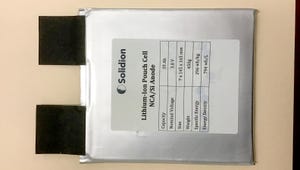Global Battery Industry’s 2024 Mission: Control the Chaos
Battery industry principals share their perspectives on the industry’s growing pains and challenges as a new year unfolds.
January 17, 2024

After a tumultuous year that saw a record number of EVs sold in North America along with significant pullbacks in plant construction, including major battery plants, dealing with powerful shifting external and internal pressures marks a global battery industry that will continue staking new claims in a variety of areas as batteries themselves, the devices they power, and the issued they address continue evolving.
This sampling of industry principals invited by Battery Technology each offer brief business perspectives and predictions from their respective businesses and areas of expertise. Together they form a dynamic and emerging portrait of a rapidly changing industry with plenty of developments forthcoming.
Mobile device demand
Ricky Hanna, CEO, ION Storage Systems: “The world is rapidly evolving toward a more resilient, mobile, and electrified economy, emphasizing the crucial role of alternative technology in shaping future electrification. While Li-Ion has its place, it comes with many inherent limitations. There is a global demand for new technologies that offer enhanced safety, increased energy density, and sustainability to power the upcoming decades.
“EV owners want faster charging options, longer range and safer batteries; device owners want longer run time and the ability to use their devices in any environment; home and business owners are looking for cleaner, more cost-effective energy sources to power their needs. Furthermore, there's a growing preference for batteries that are domestically sourced, sustainable, and recyclable.

Ricky Hanna, CEO, ION Storage Systems. Image courtesy ION Storage Systems.
“At the forefront of companies leading this transition, ION is committed to unleashing the true potential of next generation, solid-state battery technology. Our “unicorn” battery technology is now ready for primetime. Rejecting the constraints and compromises of legacy battery systems, we envision our solid-state battery as a catalyst for a revolutionary leap in battery chemistry, architecture, and manufacturing. Born from deep experience, and built upon a proven and diverse cross-industry team, we bring a transformational approach focused on manufacturability and product delivery to a competitive marketplace.”
Generative AI and the battery bust
Raj Talluri, CEO, Enovix: “With the rise of generative AI and applications like ChatGPT and Stable Diffusion, smartphone battery life can’t keep up, forcing users to make tradeoffs like not using their full display resolution or pausing their day to charge a dead device. Making phones larger to fit a bigger battery isn’t the solution—consumers have been clear they don’t want a device that won’t fit in their pocket.

Enovix announced late last year Accurate Meditech chose Enovix batteries for their new blood-pressure monitors due in part to a 35% increased run time. Image courtesy Enovix.
“One of the only viable alternatives is replacing lithium-ion graphite with silicon, which increases battery density and life by 20-30% and is a widely available and sustainable material. Consumers will be able to use smartphones to their full capacity, while truly having all-day battery charge. In the coming year, I predict we will see new entrants to the battery market using alternative materials, like silicon, to power the smartphones of the future and usher in a new era of battery life.”
.jpg?width=700&auto=webp&quality=80&disable=upscale)
Raj Telluri, CEO, Enovix. Image courtesy Enovix.
Lithium and its alternatives
Barry Perlmutter, Perlmutter & Idea Development LLC: “The lithium and battery materials market is made up of many different sectors such as lithium production, battery materials, both metal powders and liquid electrolytes and finally recycling. In 2023, lithium production is moving away from traditional mining to more environmentally-sound production from geothermal brines. These brines have been used for heating as well as bromine production but now there are developments from recovering lithium from these brines. This is ongoing in Europe as well as in the US in the Smackover Formation (Arkansas) and the Salton Sea (California).
“As for battery materials, there are the current battery designs using lithium, cobalt, nickel and manganese. A more growing area is in the LFP designs, using lithium and iron phosphate. Another promising area are zinc batteries and sodium batteries. Both are different but they hold the potential to replace lithium-ion batteries in certain applications.”
The circular economy and other factors
Lie Shi, CEO, AM Batteries: “Expect little stimulus out of Washington with a split Congress, except for sectors combating climate change and for semiconductors' industry. The money flowing out of the IRA, BIL, and CHIPS Act will accelerate in 2024 before the presidential election in November.
“Cleantech companies must adopt circular economy practices, focusing on resource efficiency, recycling, and reducing waste. The battery industry will recognize that one big reason LIB has not been more successful is because the process is very energy consuming, dirty (nasty solvent), and capital-intensive. The industry will create more efficient and cleaner ways to make LIB in 2024.
“Spurred by falling battery prices, electric vehicles could hit price parity with fossil-fuel models in Europe in 2024 and the U.S. market in 2026. For 2024, the growth of the EV market will still be there, but it may reach the inflection point, from which, the growth will be linear, rather than exponential.”

Lie Shi, CEO, AM Batteries. Image courtesy of AM Batteries
Dual-chemistry EV battery with 600+ mile range
Mujeeb Ijaz, CTO, Our Next Energy – ONE: “In 2023, ONE made incredible progress on its mission to double the range of electric vehicles and establish a U.S. battery industry. In late November, ONE announced its Gemini dual-chemistry battery achieved 608.1 miles of range in a BMW iX on a single charge. The milestone was achieved using a WLTP test cycle, the European standard for determining the range of fully electric vehicles. In 2024, ONE will focus on further refinements to the Gemini system to prepare for commercialization. These include improving the efficiency of the DC-to-DC converter, developing enhanced control algorithms to optimize use of the range extender cells and conducting further battery validation and cell development. All these steps are intended to further improve range and to prepare for the development of an A-sample for a full production program.
“Also in November, ONE started production of domestically made lithium iron phosphate (LFP) battery cells, one year after the commitment to launch ONE Circle, a 20 GWh battery factory complex in Van Buren Township, Mich. The start of cell production at ONE Circle is a major step toward establishing an LFP battery industry in the U.S. supported by a North American supply chain. In the first half of 2024, ONE will begin delivering cells to customers to validate performance and durability. By the end of next year, ONE will launch a larger multi-GWh scale LFP battery cell line.”

In 2024, ONE will focus on further refinements to the Gemini system, which achieved 608 miles of range in a BMW iX (pictured), to prepare for commercialization. Image courtesy ONE.
A Cost-effective supply chain
Venkat Srinivasan, Director, Argonne Collaborative Center for Energy Storage Science (ACCESS), Argonne National Laboratory: From around 2020-2021 through 2023, the big thing we’ve been thinking about is supply chain, supply chain, supply chain. If there are supply chain problems in the battery industry today, how do we improve things and make them more cost-effective? How do we diversity and look at alternatives for nickel and cobalt? And lithium?
This decade is lithium’s decade. In addition to ongoing R&D on battery materials and chemistries, we need to find better ways to extract the materials we do have and pay closer attention to all sources, such as the waste stream and recycling efforts. And we will continue looking for niches where alternative battery chemistries can approach scale production. At Argonne, we think about EVs and light-duty electric vehicles, but there are also heavy-duty vehicles, marine, aviation, and many more applications. We also think about the grid. Many of these examples will move beyond lithium-ion approaches, but how do we achieve the right battery chemistry for the right applications, given the constraints of energy density, weight, material availability, supply chain logistics, and costs.
We will remain deeply engaged in these and other energy-storage efforts and continue playing a leading role in providing efficient and cost-effective battery solutions for 2040, 2050, and beyond.”

Venkat Srinivasan, Director, Argonne Collaborative Center for Energy Storage Science (ACCESS), discusses battery research with Meinan He, Postdoctoral Appointee, in one of the energy storage discovery labs at Argonne National Laboratory.
About the Author(s)
You May Also Like





